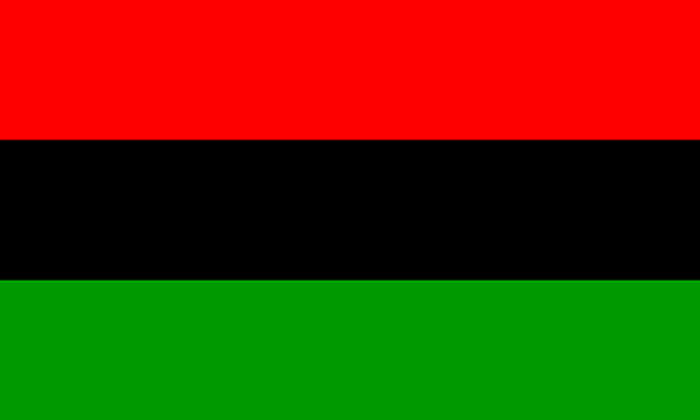
African~American Day
19 June 2021

The American Community Survey, compiled between 2008 and 2012 and being the most recent analysis, identified 0.6% of the total population of Bedford County as descending from African ancestors.
For many decades, school children learned that President Abraham Lincoln issued the Emancipation Proclamation on 22 September 1862. The Emancipation Proclamation declared slavery ended. But for the enslaved Africans and descendants of Africans held in bondage throughout the Confederacy, true emancipation did not come immediately.
As the Union Army moved through the states who were in rebellion against the United States of America, the black slaves were liberated. The Union Army finally arrived in Texas in the summer of 1865. The liberators arrived at Galveston, on the Caribbean coast on 19 June 1865 to declare slavery in the Lone Star State at an end.
General Granger read General Order Number 3 to the black people of Galveston: "The people of Texas are informed that in accordance with a Proclamation from the Executive of the United States, all slaves are free. This involves an absolute equality of rights and rights of property between former masters and slaves, and the connection heretofore existing between them becomes that between employer and hired laborer." Upon hearing those words, many of the freed black people traveled throughout the southern states to search for and reunite with family who had been snatched away.
From private celebrations of June 19th as the date which led to the reunion of their families to revelries of the day in more public ways, the holiday became known as Juneteenth. For many years the holiday of Juneteenth was confined to Texas. Many black families celebrated the day by making pilgrimages back to Galveston.
As the 1900s began, school books spoke of the Civil War in terms of national rather than local events. While the Emancipation Proclamation of 1863 was noted, and therefore learned by young black minds, the news of that emancipation carried by General Granger into Texas in the summer of 1865 was left out of the history lessons. The celebrations of Juneteenth were kept alive in the family, if not in the public, consciousness.
The Depression of the 1930s also had a negative impact on Juneteenth celebrations. Many black men were forced, by the economic situation, to take jobs in which they had little hope of being able to take off work to celebrate the holiday.
Through the early 20th Century, the consequences of racism and forced segregation affected the celebration of Juneteenth. The trials and tribulations endured by the people tended to define how the holiday would be observed. So often, the white people into whose midst the freed black families moved denied them access to public spaces. As a result, Juneteenth festivities were frequently celebrated in rural settings, at first on church grounds and later on private properties as more and more former slaves found employment and were able to buy property of their own. Because of the rural settings in which the holiday was celebrated, the festivities came to be filled with physical pastimes and competitions. Surrounded by nature, barbequing became popular and the barbeque pit often was the center of attention in Juneteenth celebrations.
During the 1950s and 60s, racial tension and strife of the Civil Rights movement throughout the United States helped to spread the fervor of the holiday throughout black communities. Many student demonstrators studied the lives of their enslaved ancestors, and in the process gaining a newfound interest in the traditions of their forefathers including Juneteenth.
Knowledge of the celebration of Juneteenth spread to white communities as the nation pulled itself out of the segregationist policies of the past. It also gained the status of an official state holiday in Texas when, on 1 January 1980, House Bill 1016 introduced into the Texas Legislature by Albert E. Edwards was passed. Representative Edwards established Juneteenth USA, an effort to have the holiday recognized throughout the United States of America. In recent years, the holiday has come to be recognized by forty-seven states and the District of Columbia.
The foods and drinks enjoyed by African~Americans are difficult to identify. That difficulty arises from the fact that the people who came from Africa came from many different countries on that continent. Much of what has come to be known as foods traditionally eaten by the enslaved people of African descent in the United States may have originated in the cuisine of the 'American South'. As a result, much of what is considered traditional African~American foods bear traces of Creole, Cajun and other 'southern' styles of cooking.
Pigs provide a number of dishes in addition to the standard bacon and ham. Pork Ribs vary in flavor and texture depending on what section of the ribs they come from. Regardless of the cut, pork ribs are usually prepared by roasting them for three to four hours. By that time, the meat will literally drop off the bones. They can by rubbed with a variety of spices or brushed with barbeque sauce. Spare ribs come from the belly side of the rib cage. Although the amount of meat on the bones is less than other ribs, they are perhaps more flavorful. Baby Back ribs come from the 'pork loin' located at the top of the rib cage and are meatier than other ribs. Rib Roast is the whole loin with the ribs attached. Ham hocks come from the extreme shank end of the legs of the pig. It basically consists of tendons and ligaments which require extended cooking to make it palatable. Ham hocks are sometimes used to flavor other dishes because they have a strong and distinctive flavor. When eaten as a dinner itself, ham hocks may be paired with collard greens, cabbage, green beans or navy beans. It should be noted that the Pennsylvania Dutch (German and Swiss) use Ham hocks in the making of Scrapple which is fried and eaten with maple syrup. , or variously Pork jowl, comes from the pig's cheek. The flavor and texture of Hog jowl is similar to bacon and is fried similarly. Eating Hog jowl and black-eyed peas on New Years Day was considered a good luck charm for the coming year. The third dish that is derived from pigs is called Hog maw. It consists of the stomach of the pig, and if cleaned properly will be devoid of all fat. The maw is then cooked in a variety of ways: fried, boiled, stewed or baked. It is often paired with Chitterlings which is the large intestines. The chitterlings are soaked in cold water until cleaned of all foreign matter. Then they are placed in a pot of water which is brought to a boil. Seasonings such as salt, pepper and garlic are added to the pot and the temperature turned down so that the contents simmer for three or four hours. Chitterlings may be seasoned before being eaten by vinegar or a hot sauce depending on the diner's preference.
Second to pork, poultry has been a traditional source of meat for African~Americans. Broiler chickens are bred specifically to provide meat as compared to egg production. Broiler chickens provide the meat for Fried Chicken in addition to side dishes such as Chicken Livers and Chicken Gizzards. The livers of many animals are eaten fried and chicken livers are no exception. In some cases, chicken livers are dipped in egg and rolled in cornmeal before frying. They can also be simply fried or deep-fried in oil. The gizzard is a 'second' stomach found in fowl. It is considered a muscular stomach compared to the true stomach which breaks down food with gastric juices. Birds do not have teeth, so some things they swallow are hard to digest. The gizzard receives the food material that is not broken down (i.e. digested) in the true stomach. Small stones swallowed by the bird reside in the gizzard and the undigested food that passes on to the second stomach is crushed and ground up by those small stones. Chicken Gizzards may be fried, grilled or even boiled. They are sometimes paired with rice.
Fish, including catfish, bluegill and whiting is most often battered with a cornmeal batter and then fried. 'Fish frys' provide the reason for community gatherings. Fish filets will be breaded or battered in egg and cornmeal or bread crumbs and then fried and served alongside french fries, coleslaw and hushpuppies.
Black-eyed Peas, a type of legume, provides a bean, or seed, that is cooked as a side dish. Traditionally, black-eyed peas are cooked with some sort of pork flavoring, such as ham hocks, pork jowls or bacon. When mixed with rice, diced onions and bacon, black-eyed peas form a dish known as Hoppin' John. Hoppin' John is traditionally eaten on New Years Day to bring prosperity in the coming year. And if eaten on the day after New Years Day as leftovers, the dish is called Skippin' Jenny. A variety of plants are paired with meat dishes. Collard Greens are a type of loose-leaf vegetable in the cabbage and broccoli family. Collard Greens are similar to, and often mixed with kale. Mustard Greens provide mixtures or salads with strong mustard and horseradish flavors. A third type of loose leaf vegetable are Turnip Greens, which as the name suggests, are the fresh leaves of the turnip plant. Turnip greens resemble mustard in flavor. Sweet Potatoes and Yams are root vegetables which are very starchy. The two vegetables are commonly assumed to be related, but the sweet potato is related closely to the morning glory plant while the yam belongs to a different family and species. In the United States, the vegetable most often eaten is the sweet potato. They are prepared much like the potato: mashed, baked, broiled or sliced and fried. When they are mashed and baked with a topping of brown sugar and marshmallow or molasses, the dish is known as Candied Sweet Potatoes. Candied sweet potatoes are traditionally eaten at Thanksgiving dinners.
African~Americans, deriving many of their grain-based foods from the cuisine of the American South, include foods such as Grits, Cornbread, Johnnycake and Hushpuppies with their meals. Grits consist of cornmeal that is coarsely ground and boiled. Being called Hominy Grits, means that it is made from dried corn kernels that have been treated with a dilute solution of lye to kill the seed's germ. Grits are traditionally boiled in milk to form porridge. Grits can be flavored with sugar, butter or even grated cheese. Cornbread is what its name suggests: bread made from cornmeal. In the American South, cornmeal is simply mixed with buttermilk and baked. Elsewhere it might have sugar and eggs added before baking. Johnnycake, variously called Hoecake, is a type of cornbread which uses cornmeal that is ground very fine. The cornmeal is mixed with either water or milk and a little salt and baked in a skillet. The name is derived from generations ago when the cake would be baked on a type of iron frying pan called a 'hoe.' Some sources claim that the name 'johnnycake' comes from the name 'journey cake.' The final grain-based food embraced by Americans of African descent is Hushpuppies. Hushpuppies are deep-fried balls consisting of cornmeal mixed with flour, buttermilk, eggs, sugar, salt and baking powder.
Sweet Potato Pie is a dessert favored by many African~Americans. Sweet potatoes are cooked and then pureed to the consistency of a creamy paste. Spices, eggs, sugar and evaporated milk are stirred into the pureed sweet potato which is then poured into an open pie shell. It is similar to pumpkin pie and may be topped, like pumpkin pie, with marshmallow or just cinnamon. The pie is topped sometimes with a pecan topping made from pecans, melted butter and brown sugar and baked.
Beer probably tops the list of alcoholic beverages preferred by Americans of African descent with vodka and whiskey coming in as close seconds and thirds.
Additional Information Might Be Added Here. Please Check Back.
Click on this logo to return to the Calendar page.

